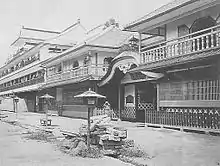Yūkaku
Yūkaku (遊廓) were legal red-light districts in Japanese history, where both brothels and sex workers (known collectively as "yūjo" (遊女, lit., "woman of pleasure"), the higher ranks of which were known as oiran (花魁)) recognised by the Japanese government operated.[1] Though sex work was, officially, legal to engage in and pay for only in these areas, there were a number of places where sex workers and brothels operated illegally, known as 'Okabasho' (岡場所), the generic name for all unlicensed red-light districts other than Yoshiwara (later including both Shimabara and Shinmachi.[2]

In January 1946, GHQ issued an order (SCAPIN 642) nationwide to abolish Japan's legalised system of sex work, with brothels in the yūkaku areas having to change their names to either that of "café" (カフェ) or "ryōtei" (料亭/りょてい), with the yūkaku being renamed as "akasen" (赤線, lit., "red line") districts.
Following this, the Anti-Prostitution Law (売春防止法, baishun bōshi hō) was passed in 1956, before being fully enforced two years later in 1958; though the law did not criminalise all forms of sex work, the sale of sex with 'unspecified' (meaning 'unacquainted') persons was outlawed, leading to the yūkaku, and later akasen, areas to cease to exist as they once had. In spite of this, the legal sale of some sex acts and services continues to this day within Japan, circumventing the Anti-Prostitution Law either through the sale of acts that do not involve penetrative sex, or through the sale of sex only to customers who have first been 'acquainted' with sex workers.
References
- [遊郭]『大百科事典. 第25巻』 (平凡社, 1939)
- 平田(1997)109頁。